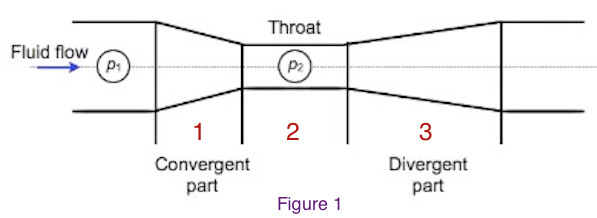Aerofoils » Venturi
Venturi

By understanding how subsonic flow (slow air-speed) through a contraction or Venturi (named after an Italian physicist) the process of how an aerofoil works can be determined.
Consider incompressible air-flow through a duct or Venturi, the mass flow rate (cubic metres per second) through one part of the duct will be the same through any other part of the duct. The few losses are ignored.
This draws the conclusion that if the duct cross-sectional area decreases referring to convergent part (Position 2 in Figure 1), the velocity of the flow must increase to keep the total mass flow rate equal to the flow rate at the entrance (Position 1 in Figure 1) of the venturi. Therefore at divergent part of the tube, the air velocity should reduce in order to maintain constant flow rate.
According to Bernoulli’s statement, the energies at position 1 = position 2 = position 3 of Figure 1.
In a free stream of flow the total energy is constant and is made up of the following:
Total energy (J) at a point = pgh + 1/2pV2 + P
i.e. the total energy at point 2 should equal the total energy at point 1, meaning:
pgh1 + 1/2pV21 + P1 = pgh2 + 1/2pV22 + P2
(in this equation the value at point 1 and point 2 are taken with same parameters)
To maintain the same volume of flow rate the fluid in position 2 must move faster than at position 1, hence V at position 2 has to increase, which means in the above equation the sum in the right side is bigger than the sum in the left but that cannot happen. Therefore one of the terms on the right must reduce for equation to balance out and be equal.
Through analysing, it was established that pgh2 does not change, the centre line (h) is horizontal and its height does not change. So P2 must be lower than P1 which means the pressure should drop.
The same analysis can be applied to an inclined duct of uniform cross-section. As height (h) changes, the pressure (p) changes in the opposite direction (if h increases, then p reduces for the balance of the equation to remain unchanged).
If air enters a convergent duct at a speed equal or greater than the speed of sound it would behave as if it was compressible, shock waves would hence form at convergence and the velocity would decrease with a rise in pressure and density.
Note: For supersonic speeds Bernoulli’s Theorem is not applicable.
Aerodynamic LIFT
By using wings and rotor blades, fixed wing aircraft and helicopters are able to support themselves in the air. In reference to these two cases, air is caused to flow over the aerofoil section of the wing or rotor blades, which causes a pressure difference between the top and bottom surfaces to produce an upward force. This upward force is produced by the Venturi Effect.
Venturi Effect
Air passing through a duct which contracts to a throat, can be shown by a simple experiment (Bernoulli) in which the air pressure called the static pressure, drops at the throat where the air velocity is at its fastest.
Through representing the airflow by drawing streamlines of the flow of air through a Venturi it can be seen that the streamlines are forced together at the throat where the speed is the greatest and the pressure is the lowest (refer to figure ). P1 and V1 are normal, P2 is low and V2 is high.

It is strange but true that if the top and bottom sides of the Venturi were free to move they would move closer together because of the low pressure between them.
